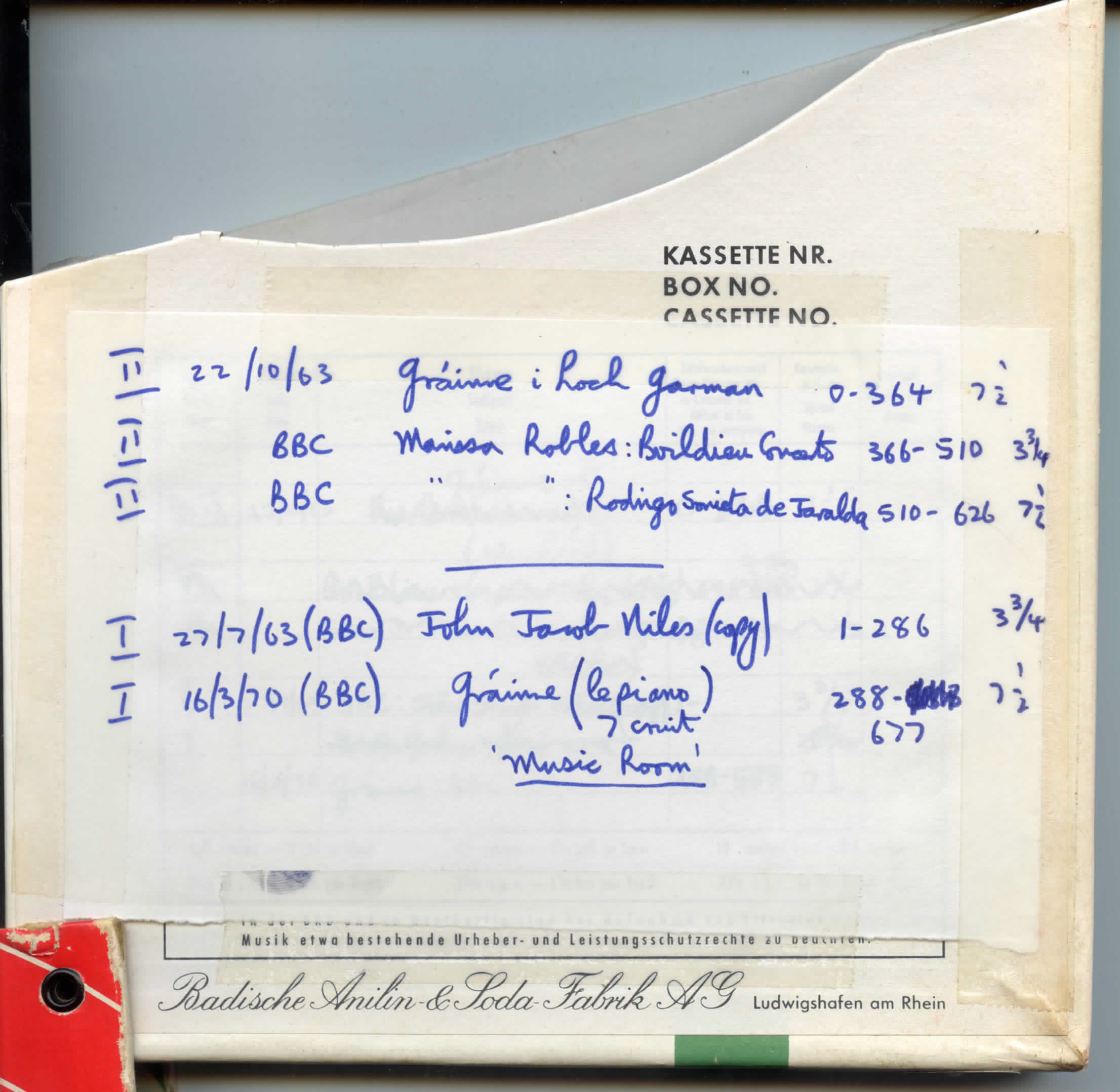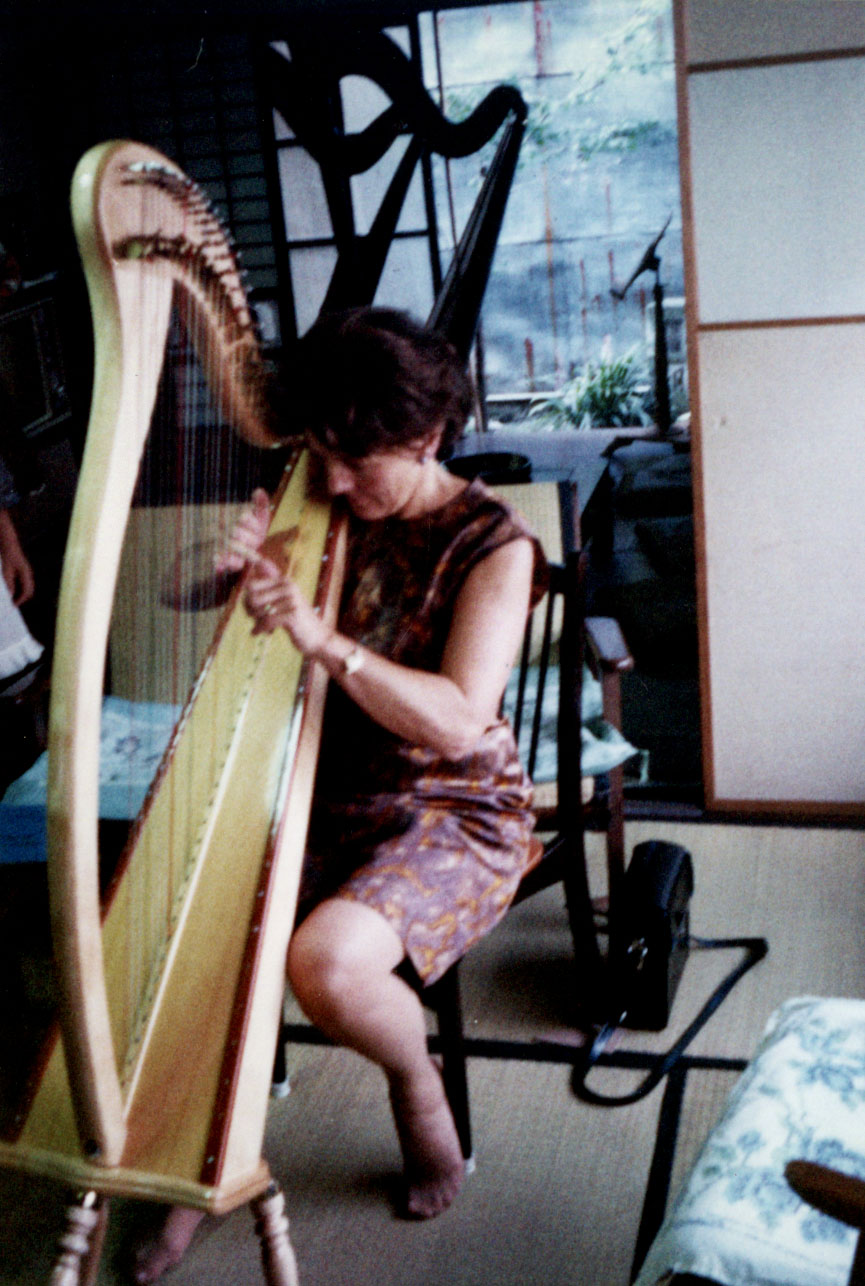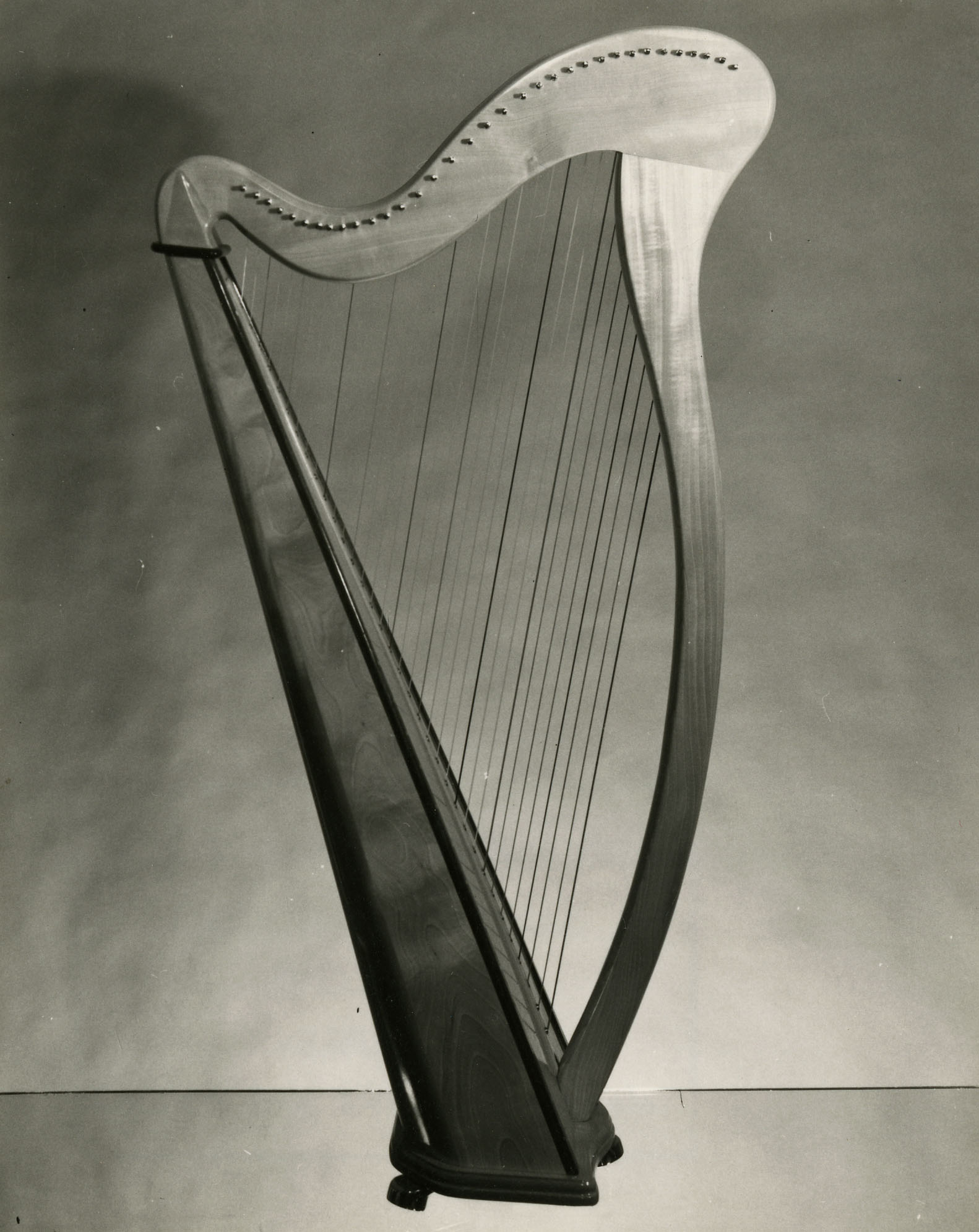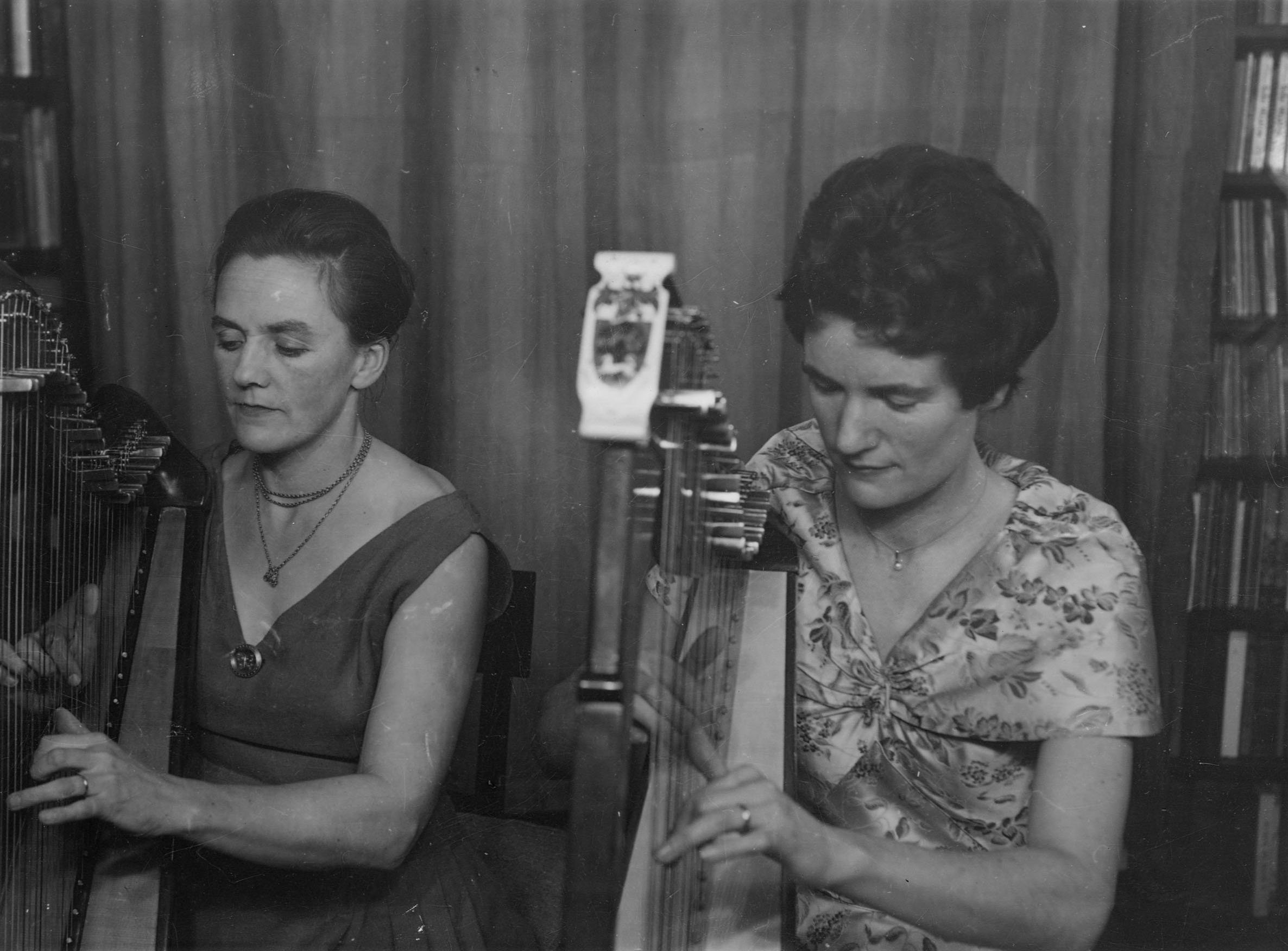



The Irish Traditional Music Archive (ITMA) is committed to providing free, universal access to the rich cultural tradition of Irish music, song and dance. If you’re able, we’d love for you to consider a donation. Any level of support will help us preserve and grow this tradition for future generations.

Today the 14th April 2025 marks the centenary of the birth of singer and harpist Gráinne Yeats (née Ní Éigeartaigh). Yeats studied the harp in her late twenties, at which point she was already an established singer. Her involvement with the instrument coincided with a revival of harping in Ireland, which she contributed to through a varied career as a performer, presenter, teacher, researcher, arranger and advocate, raising the profile of the instrument both nationally and internationally.
The Gráinne Yeats Collection was donated to ITMA by the Yeats family in April 2018. It comprises printed books, music manuscripts and arrangements, research notes, correspondence, lecture scripts, diaries, artefacts, ephemera, an extensive image collection, and both commercial and non-commercial recordings. The focus of this blog post is the forty-seven reel-to-reel tapes within the collection, which feature recordings of Yeats and other musicians dating predominantly from the 1960s and 1970s.
Radio broadcasts make up a large proportion of Yeats’ reel-to-reel collection, and are perhaps the most significant element, given the ephemeral nature of this form. Broadcasts by other musicians lend an insight into her listening interests which included music in a variety of styles with a focus on classical and to a lesser extent traditional music. Examples of orchestral and chamber music include compositions by nineteenth-century composers Berwald, Brahms, Chausson, Grieg, Schubert, Smetana and Tchaikovsky and twentieth-century works by Boulez, Britten, Gerhard, Henze, Ravel and Stravinsky. Of significance in an Irish context are recordings of violin soloist Geraldine O’Grady and of Brian Boydell’s ‘Shielmartin Suite’, commissioned by the BBC for the 1960 Festival of Light Music in London. There is a particular emphasis on the harp, which features in broadcasts by Irish and international pedal harpists including Annie Challan, Chantal Mathieu, Sanchia Pielou, Marisa Robles and Caitríona Yeats. The Irish harp is also represented through recordings of Mercedes Garvey (née Bolger) in duets with Yeats and through a recital by French harpist Régis Chenut, broadcast on Radio Éireann’s Music Room in 1971. His repertoire includes ‘O’Neill’s March’, ‘Imeacht na Sí’ written by Irish harpist Anne Crowley and his own composition, ‘Fantasie Irlandaise’.
Yeats’ interest in vocal music is reflected in performances of historical and renaissance vocal music, Italian and Spanish opera, and songs by Hindemith, Granados and Guridi. Contemporary compositions by Berio and Tavener also feature, while the inclusion of performances by singer, composer and contemporary artist Cathy Berberian and by singer-songwriter and activist Joan Baez demonstrate Yeats’ broad musical tastes.
Harp and vocal music are also the subject of radio talks and documentaries within the collection. Harping examples include an introduction to the instrument by Osian Ellis, a discussion of Welsh triple harping by Joan Rimmer and programmes on Turlough Carolan presented by Donal O’Sullivan with illustrations by harpist Sheila Larchet Cuthbert. Vocal music is explored through documentaries on Italian and American folk music and a programme on the Irish song collection Amhráin Mhuighe Seóla.

A valuable selection of Yeats’ own performances and broadcasts is also captured. Tapes of live performances show how Yeats interacted with audiences and introduced repertoire, reflecting the depth of her knowledge and her skill in presenting to national and international audiences. Illustrated radio talks on topics including early Welsh harp music, the Gaelic songs of Ireland, ‘Harp and Voice’ and ‘Turlough O’Carolan and His Friends’ show further evidence of Yeats’ ability to share her research in an informative and engaging manner. Her classical training is to the fore in recital-style broadcasts of songs by Dallapiccola and Hindemith, while examples of her contributions to Radio Éireann’s Irish language and Irish traditional music programmes are also preserved.
Broadcasts for the Canadian station CBC and recordings of live performances in America demonstrate Yeats’ championing of both historical and contemporary Irish music in international contexts. Having toured regularly in the USA and Canada from 1965, she expanded her international profile in 1972 through performances in Russia and Japan. She discusses her experiences in a Radio Éireann Music Hour broadcast, noting that:
As far as I know, I am the first Irish artist ever to have given concerts in either of these countries, and I was very proud that I was able to bring Irish music, both traditional and harp and the art music written by our present-day composers to the peoples of Russia and Japan.
She speaks of the warmth with which Irish music was received in Japan, and recalls that one of the highlights of her trip was visiting the town of Fukui, where she was presented with a nylon-strung harp made by local harp-maker Kenzo Aoyama.


Both broadcasts and performances shed light on two significant collaborations in Yeats’ career – her harp duets with Mercedes Garvey and her work with the Dowland Consort, a Renaissance music vocal ensemble founded and directed by composer Brian Boydell. Of particular note is a private recording of the Consort’s final concert in Trinity College Dublin in November 1969. Collaborations with family members are also included. Yeats delivered lecture-recitals with her husband Micheal Yeats and performances for harp and voice with her daughter, harpist Caitríona Yeats, examples of which are captured in the collection.

One of the most interesting features of the reel-to-reel collection is the rich insights it provides into Yeats’ repertoire, which included instrumental music, song with harp in a variety of languages and unaccompanied singing in Irish. Her role in expanding the repertoire of the harp, both through the exploration of historical music and the commissioning of contemporary works for the instrument is particularly evident. Having studied History in Trinity College Dublin, Yeats took an active interest in researching historical harp traditions and was a key figure in the twentieth-century revival of the wire-strung harp. This is reflected in recordings across the collection, in particular through performances of historical harping repertoire from Ireland and Wales.
In tandem with her role in exploring the harp’s history, Yeats was responsible for commissioning and premiering several new works for the Irish harp. As daughter-in-law of the poet W.B. Yeats, she was in a position to commission settings of his poetry without the usual difficulties pertaining to copyright. Several such works by Brian Boydell, James Wilson and Peter Aston are present within the collection. Performances of contemporary music for BBC’s Musicale in the late 1960s and early 1970s and Radio Éireann’s Twentieth Century Irish Songs in 1968 also feature, along with a 1976 recording of repertoire from The Irish Harp Book. The largest collection of contemporary music for the Irish harp to date, The Irish Harp Book was published by Cairde na Cruite, a harping organisation of which Yeats was a founding member. In collaboration with Mercedes Garvey and editor of the publication, Sheila Larchet Cuthbert, Yeats introduced and performed compositions from the volume in two Radio Éireann broadcasts, one of which features within this collection.

Across the tapes, the breadth of Yeats’ musical activities and musical interests is apparent. The reel-to-reel collection captures her listening interests, preserving a valuable selection of radio broadcasts from the mid-twentieth century, and also presents a fascinating means of exploring Yeats’ own multifaceted career. Other elements of the collection complement the recordings, including radio scripts, performance notebooks, scores and correspondence with composers. The safeguarding of this material by ITMA ensures that her significant work can continue to inspire.
Rachel Duffy is a harper from Bray, Co. Wicklow. She has a keen interest in both the Irish harp’s history and its contemporary transformation, which is the subject of her doctoral studies at Technological University Dublin. She is active as a performer and teacher and is co-director of Cairde na Cruite’s annual international harp festival, An Chúirt Chruitireachta.
ITMA would like to thank the Yeats family and Mercedes Garvey for permission to use recordings for this blog.
ITMA would also like to thank RTÉ Archives for permssion to use tracks 1 & 9 in the accompanying playlist.
Track 1 – Performance of ‘Imeacht na Sí’ (comp. Anne Crowley) by Régis Chenut (harp) in a recital for Irish harp broadcast on Radio Éireann’s Music Room in 1971
Track 9 – ‘Spanish Arch’ (comp. James Wilson) performed by Gráinne Yeats and Mercedes Bolger (harp duet) as part of a 1976 Radio Éireann broadcast on the Irish Harp Book